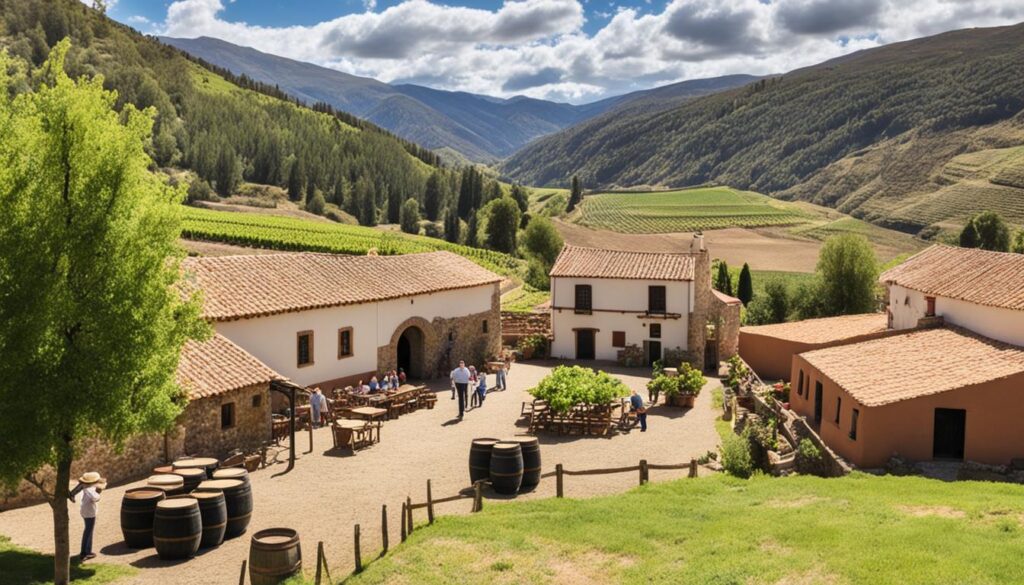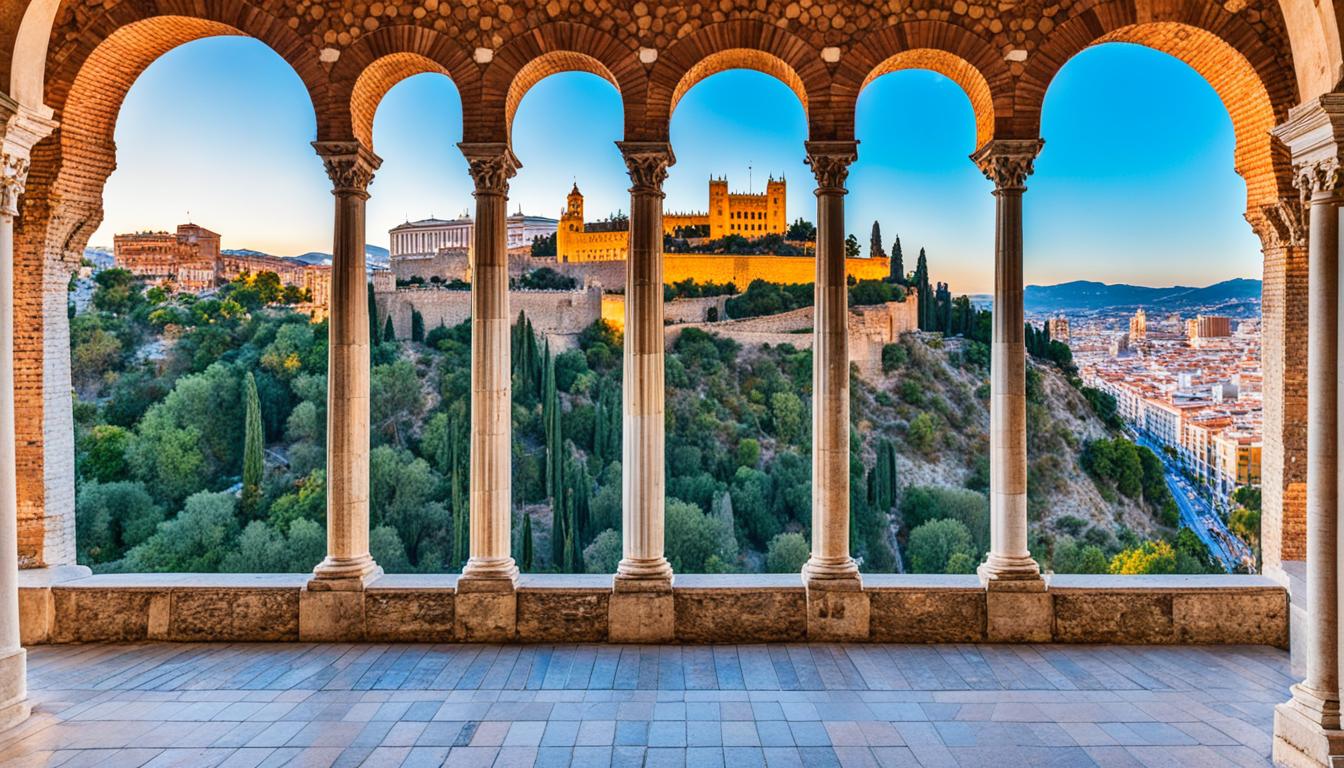Malaga sits by the Mediterranean, full of historical wonders. It’s a city where ancient history meets modern life. From the old Alcazaba fortress to the famous Malaga Cathedral, there’s much to see. Let’s explore Malaga’s landmarks and hidden spots together. Each step tells a story of the city’s past and present.
Key Takeaways
- Malaga is one of Spain’s oldest cities, with a history dating back to the 8th century BC.
- The city’s diverse influences, from Romans and Moors to Christians, have shaped its rich cultural tapestry.
- Iconic sites like the Alcazaba, Roman Theater, Malaga Cathedral, and Gibralfaro Castle offer glimpses into Malaga’s storied past.
- The Picasso Museum and Malaga Bullring showcase the city’s artistic and cultural heritage.
- Malaga’s beautiful beaches, local tapas scene, and vibrant annual festivals create a modern, lively atmosphere.
About the City of Malaga
Malaga is the heart of Costa del Sol, showing off Andalusia’s beauty, culture, and history. It sits on Spain’s southern coast, with a mix of hills and beaches. This city is a perfect example of Spain’s diverse landscapes.
Geographical Splendor
Malaga is set between the Mediterranean Sea and the Montes de Malaga mountains. This spot makes it a stunning place, blending sea and mountains beautifully.
Historical Tapestry
Malaga’s story is full of different cultures, starting with the Phoenicians around 770 BC. The Romans, Moors, and Christians have all left their mark. You can see this history in places like the Alcazaba fortress and the Málaga Cathedral.
Cultural Mosaic
Malaga’s culture is a mix of old and new. It’s known for flamenco, tapas, and a strong art scene. Places like the Picasso Malaga museum show off the city’s artistic side.
Modern Vibrancy
Malaga isn’t just old; it’s also modern and growing. The city center is full of new buildings and lively spots. It’s a place where history and modern life meet.
A Guide Around Malaga’s Hidden Gems
Beyond Malaga’s famous spots, there’s a world of hidden gems, secret spots, and places waiting to be found. This guide takes you on a journey to discover Malaga’s hidden treasures. You’ll see everything from peaceful gardens to historic areas, modern art spaces, and traditional flamenco places. These spots let you see Malaga’s culture, history, and beauty in a new way.
Malaga is known for its beautiful beaches, busy harbor, and old town. But it also has many hidden gems that most tourists don’t see. By exploring off the usual paths, you’ll find a city full of surprises.
- Discover the tranquil Jardin de la Concepcion, a lush botanical oasis showcasing an impressive array of rare plant species.
- Step back in time at the Lagar de Torrijos, a historic winery that offers a glimpse into Malaga’s rural heritage.
- Immerse yourself in the avant-garde art scene at the Centro de Arte Contemporaneo (CAC), a cutting-edge museum that celebrates the city’s cultural vibrancy.
- Unwind at the Peña Juan Breva, a flamenco sanctuary that preserves the rich traditions of this iconic Spanish art form.
- Discover the culinary delights of El Palo’s Fishermen’s Quarter, a hidden gastronomic hotspot that offers a glimpse into the city’s maritime heritage.
These are just a few of the many hidden gems waiting for you in Malaga. By exploring the city’s secret spots, you’ll find stories that make your visit unforgettable.
Jardin de la Concepcion – A Botanical Hideaway
Just outside Malaga’s busy city center, the Jardin de la Concepcion is a 19th-century botanical oasis. It was created by the Marquises of Casa Loring. This place is a 23-hectare paradise with over 50,000 plants from more than 2,000 species.
Walking through the Jardin de la Concepcion, you’ll find peace and beauty. This 3.5-hectare garden is a Historical-Artistic Garden since 1943. It has many landscapes, including:
- The Around the World in Eighty Trees path, with 80 tree types
- The World Atlas of Palm Trees garden, with up to 75 palm species
- Themed gardens like the Prehistoric Plants, Rockery of Biodiversity, Garden of Succulents, and Plants of Our Land
- A greenhouse with carnivorous plants, bromeliads, and orchids in a tropical setting
As you explore, you’ll see the city from above and find ancient ruins and hidden spots. The Jardin de la Concepcion is a peaceful place away from the city. It lets visitors enjoy Malaga’s botanical gardens and their rich biodiversity.
| Fact | Statistic |
|---|---|
| Size of the Jardin de la Concepcion | 23-hectare site located in the north of Málaga, on the banks of the Guadalmedina river |
| Number of plant species | 50,000 plants, belonging to more than 2,000 tropical, subtropical, and native species in the Botanical Garden of Málaga |
| Size of La Concepción Botanical Garden | 3.5 hectares of land |
| Historical designation | The estate was declared a Historical-Artistic Garden (Asset of Cultural Interest) in 1943 |
Lagar de Torrijos – A Glimpse into Rural Life
The Lagar de Torrijos is in the Montes de Malaga, a beautiful natural park. It covers 4,996 hectares and lets visitors experience Andalusia’s traditional rural life. This 19th-century farmhouse, now a museum, is set among vineyards and olive groves. It shows the area’s farming history.
The Montes de Malaga has uneven land, limestone soil, and many plants like Aleppo pines and holm oaks. It’s close to Malaga’s city center, making it a perfect spot for nature lovers. Here, you can see wildlife like genets, wild boars, and birds of prey.
At Lagar de Torrijos, you can see how Malaga’s sweet wines are made. The farmhouse is beautifully restored and shows the old farming ways. It connects visitors to the Andalusia agriculture and malaga rural life heritage.
Visiting the Lagar de Torrijos is great for history, culture, or food lovers. It’s a key spot in the Montes de Malaga area. You’ll experience the beauty and traditions of rural Malaga.

“The Lagar de Torrijos is a true gem, offering a captivating window into the agricultural heritage and traditional rural lifestyle of Andalusia. A must-visit for anyone seeking an authentic, immersive experience in this stunning region.”
malaga historical sites
Malaga’s history is alive in its iconic sites, each telling a piece of the city’s story. From the Alcazaba of Malaga to the Roman Theater Malaga, these landmarks showcase Malaga’s rich culture.
Alcazaba of Malaga
The Alcazaba of Malaga sits high, overlooking the city. It’s a Moorish fortress from the 11th century. Built from 1057 to 1063, it highlights Malaga’s Moorish past. Visitors can see its courtyards, gardens, and towers that have lasted centuries.
Roman Theater Malaga
The Roman Theater Malaga is one of Malaga’s oldest sites. Built in the 1st century AD, it was used for over 200 years. Now, it lets visitors walk through an ancient amphitheater, imagining past performances.
Malaga Cathedral
The Malaga Cathedral, or Cathedral of the Incarnation, shows off Renaissance and Baroque styles. Work started in the 15th century and went on for over 200 years. Its facade and interior are full of beauty and detail.
Gibralfaro Castle
Atop Gibralfaro Hill, the Gibralfaro Castle gives stunning views of Malaga and the sea. Built in the 14th century, it was a lighthouse and watchtower. Now, it lets visitors see its walls, learn about its past, and enjoy the views.
Malaga’s historical sites show the city’s deep cultural roots. They invite visitors to explore the stories that made this place special.
Centro de Arte Contemporaneo (CAC) – The Vanguard of Art
In Malaga’s lively Soho district, the Centro de Arte Contemporaneo (CAC) stands out. It draws visitors with its modern art and deep thoughts. This museum is free and shows art from new and known artists from around the world.
The CAC leads in cultural innovation. In 2005, it showcased German artist Neo Rauch’s work at 45, with 84 pieces. This event made him a key figure in European painting.

The CAC also highlights other artists. In 2021, it featured American artist Mark Whalen for the first time. His work mixed digital and traditional art, touching on human feelings and humor.
The CAC is a place for modern art reflection. It offers exhibits, books, workshops, and seminars on the latest art trends. Its spot in the old Málaga Wholesale Market makes it even more interesting, mixing history with today’s art.
Visiting the Centro de Arte Contemporaneo (CAC) in Malaga is an adventure. It lets you dive into the cutting-edge of art. You’ll see the city’s vibrant art scene up close.
Peña Juan Breva – A Flamenco Sanctuary
In the heart of Malaga, Peña Juan Breva is a place where flamenco lives. It honors a famous flamenco singer from Malaga. Here, you can feel the true spirit of flamenco through real performances.
Picasso Museum Malaga
Malaga is also known for the Picasso Museum, a spot for art lovers. It celebrates Pablo Picasso’s birthplace. The museum displays many of his works, showing his impact on 20th-century art.
Malaga Bullring
The Malaga Bullring adds to the city’s culture. It’s where the exciting bullfights happen. Visitors can see the traditions that have shaped Spanish culture for years.
“Malaga has undergone a remarkable transformation in recent years, emerging as a vibrant hub that seamlessly blends its rich history with a modern, dynamic spirit.”
Malaga offers a mix of flamenco at Peña Juan Breva, art at the Picasso Museum, and bullfights at the Malaga Bullring. It’s a city that’s changing but still holds onto its traditions. Visitors can explore its rich culture and lively spirit.
El Palo’s Fishermen’s Quarter – Culinary Hidden Gem
Looking for a real taste of Malaga away from the city center? El Palo is a hidden treasure. This fishing area by the eastern shore lets you enjoy the Mediterranean’s flavors in its simplest form.
Malaga Beaches
Malaga has 16 beautiful beaches along the Mediterranean. From the busy La Malagueta to quiet spots, each beach is perfect for sunbathing and water sports. Spend a day enjoying the coast and the relaxed beach life.
Malaga Tapas
Malaga’s tapas are a must-try, right by the beaches. In El Palo’s streets, find cozy “chiringuitos” where fresh seafood is grilled and served with local wine. This experience shows off Malaga’s food heritage, often missed by visitors.
| Malaga Neighborhood | Unique Attractions | Notable Establishments |
|---|---|---|
| El Palo |
|
|
“In the summer, El Palo enjoys tourism hustle with locals often joining in nautical sports.”
El Palo’s fishermen’s quarter is perfect for food lovers and those wanting to dive into local culture. It’s a hidden gem in Malaga you shouldn’t miss.
Conclusion
Malaga is a city that perfectly mixes old and new, offering something for everyone. You can visit the ancient Alcazaba and Roman Theater or see modern art at the Centro de Arte Contemporaneo. This guide shows you the best spots and hidden treasures in Malaga.
The city’s historic center is easy to walk around, making it simple to see its top sights. You can walk through narrow streets, see beautiful chapels, and visit the Roman Theater. Don’t miss the Picasso Museum, Calle Larios, and Plaza de la Constitution to feel Malaga’s lively culture.
When planning your visit, don’t forget to check out Malaga’s hidden spots. Visit the Botanical and Historical Garden, Atarazanas Market, and the Bullring and Bullfighting Museum. These places give you a closer look at Malaga’s history and traditions. Malaga’s mix of old and new makes it a memorable place to visit.

